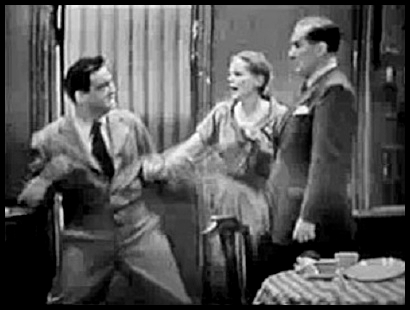Channel  : Legacy : Legacy

Bang, zoom! Alice (Pert Kelton) stops Ralph (Jackie Gleason)
from bashing an unlucky jewelry salesman in a 1951 episode of
DuMont’s Cavalcade of Stars.
“In any new medium there will be risktakers ahead
of the marketplace, some of whom fail to make it.
Who here remembers the DuMont network?”
FCC chairman William Kennard, before the
International Radio and Television Society
in New York City (October 15, 1998)
Though the DuMont network failed largely for reasons
beyond its control, its failure tarnished the DuMont name for many
years. Indeed, as noted, the company changed its name to distance itself
from the failure which it associated with DuMont.
There is no question that for many years, DuMont was
remembered as the network that did not survive, a place where the
(usually) low-budget shows were shot on a shoestring. While some of this
criticism may have been true, much of television in that era suffered
from the same faults and budgetary constraints. R.D. Heldenfels reports
some of this derision of DuMont:
...a "partial network," sniffed one old TV hand; the
"Atlantis of television," a TV critic said, thirty years
after DuMont's demise...even (the 1984 Museum of
Broadcasting tribute) coupled DuMont with Metromedia,
a chain of stations started from DuMont's remains.
It is indeed ironic that DuMont, a manufacturer of
high-quality television sets and equipment, should be primarily
remembered as a purveyor of low-budget programming. As late as 1989,
former DuMont managing director Ted Bergmann told the author of this Web
site that DuMont was still held in disregard by the television
industry; that inside references were made to "DuMont-type shows," TV
programs which were shot quickly and cheaply. In his book, Bergmann
writes:
The creation of shows with little budget for props and
scenery required ingenuity -- using shortcuts, fewer
sets, smaller casts, shorter rehearsals and new camera
techniques...We had an honest conviction that
advertisers should only be charged for those facilities
that they actually used and only at the rate that they
cost us. Our philosophy was that we were in the
business of selling airtime, not scenery, stages or talent.
Only in recent years has DuMont begun to receive its due,
largely from authors who have approached the old network anew. R.D.
Heldenfels calls DuMont "the gutsy fourth network of TV's early years."
Ron Powers writes: "It set standards in terms of versatility, range of
programming, and public service." The Museum of Broadcast Communications
in Chicago, which featured a DuMont reunion and exhibit in 1999, calls
it "one of the most creative and inventive networks in the history of
television." Jeff Kisselloff, in The Box, adds:
...only in the narrowest sense was DuMont a failure.
His contributions to the field are still being felt today.
DuMont's long-life cathode ray tube made broadcasting
possible. He put the first modern sets on the market and
was manufacturing twenty-inch sets when the rest of
the industry was selling postage-stamp-size TV screens.
Kisseloff points out, quite correctly, that the DuMont network had "more firsts than Adam":
It produced the first live network broadcast, between
New York and Washington; the first regularly scheduled
children's show, The Small Fry Club with Big Brother Bob
Emery; it introduced the first daytime schedule. It was on
DuMont's Cavalcade of Stars that Ralph Kramden first
threatened to send Alice to the moon.
To which Heldenfels adds:
It was home to the first network soap opera, the first
network newscast originating in Washington, the first
live prime-time telecasts of the National Football League
(seventeen years before Roone Arledge, who worked
briefly at DuMont, created ABC's Monday Night Football)...
DuMont had Jackie Gleason before CBS, Bishop Sheen
before ABC, The Original Amateur Hour before NBC...
Heldenfels also offers some interesting speculation on what might have happened had DuMont not folded:
Had it survived, DuMont might well have taken a less
audience-obsessed path than its counterparts.
When the other networks began dropping their live
dramatic anthologies, DuMont could well have given
them a home - and the audiences who still loved them
a new place to turn. It might have found visionary
young leaders; imagine Roone Arledge returning from
military service and finding not that DuMont had
folded in the interim, but that he could take up his
small job there and rise through the ranks at a
network as open to innovation as Arledge would be.
Then imagine the impact of Arledge competing against
ABC instead of molding its sports and news divisions.
Struggling independent stations over the years, not to
mention station licenses that went untaken for years,
would have had a better chance with a fourth network
to provide them programs - as Fox showed. And
something like the Western-show explosion of the late
Fifties, where close to a third of prime-time hours
were taken up by sagebrush and shoot-'em-ups, might
have been curtailed by a thoughtful counter-programming
strategy of a network disinclined to join the wagon train.
Lest this speculation appear a bit too rosy, Heldenfels continues:
Then again, DuMont might just have saddled up with the
rest of them. Cavalcade of Stars, after all, was an attempt
to duplicate the success of rival networks' Texaco Star
Theatre and Toast of the Town, and DuMont's programs
overall resemble the grasping of program straws as
much or more as they look like an overall strategic plan.
However, Heldenfels concludes his DuMont chapter on an
upbeat note, one which is appropriate to any consideration of DuMont's
legacy:
DuMont had its honorable place in television history,
it went boldly where others would not,
and its demise took an innovator out of a medium
already being criticized for its lack of innovation.
Go to Channel 9: Others
|

